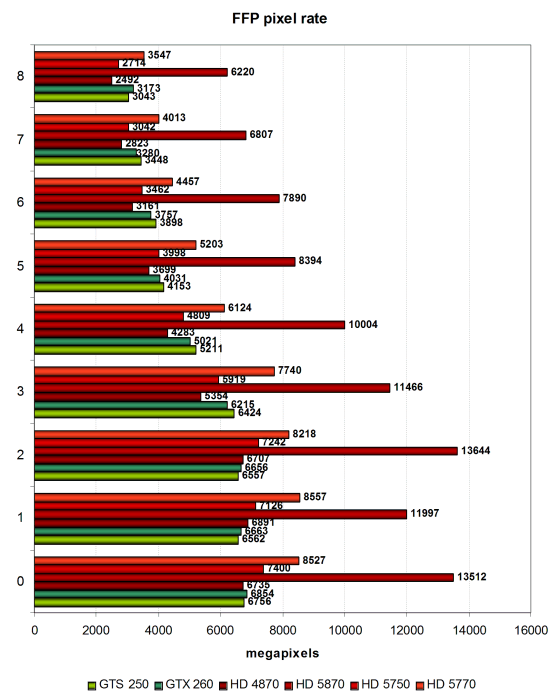ATI RADEON HD 5750/5770 1024MB
|
Synthetic tests
Testbed:
- Intel Core I7 CPU 920 (2,667 MHz) CPU
- ASUS P6T Deluxe motherboard with the Intel X58 chipset
- 3GB DDR3 SDRAM Corsair 1066MHz
- WD Caviar SE WD1600JD 160GB SATA hard drive
- Tagan TG900-BZ 900W PSU
- Windows Vista 32-bit SP1, DirectX 10.1
- Dell 3007WFP 30-inch monitor
- ATI CATALYST 9.9; NVIDIA 191.00 drivers
- VSync disabled
Our synthetic benchmarks:
Unfortunately, the time of DirectX 11 synthetic tests hasn't come yet. There is Unigine Heaven, an interesting pseudogaming benchmark, but it won't do, as it's not purely synthetic. RightMark hasn't changed as well. We hope such benchmarks will have been released by the time NVIDIA rolls out new products to compete with DX11 cards. Futuremark might release something sooner or later. But for now we'll use what we have.
Tested graphics cards:
- RADEON HD 5770
- RADEON HD 5750
- RADEON HD 5870
- RADEON HD 4870
- GeForce GTX 260
- GeForce GTS 250
We selected these graphics cards to compare with the new RADEON HD 5700 products for the following reasons: RADEON HD 4870 is a fast single-GPU card of the previous generation, its theoretical performance matches that of the new cards. RADEON HD 5870 is AMD's fastest card and the top solution from the the HD 5000 series, so it will be interesting to compare it with the new mid-end series. As for NVIDIA cards, GeForce GTX 260 competes with the higher-end HD 5700 card, while GTS 250 is a rival of the lower-end card from this series.
Direct3D 9: Pixel Filling
This test determines peak texel rate in FFP mode for different numbers of textures applied to a pixel:
This test is a little outdated, and graphics cards do not reach their theoretical maximum here, it still shows well relative ratings of graphics cards in texturing speed. Results of this synthetic test do not reach peak values. It turns out that the HD 5770 looks up about 33 texels per cycle from 32-bit textures with bilinear filtering, while the theoretical maximum here is 40 filtered texels.
Similar results are demonstrated by the lower solution -- 31 texels versus 36 theoretically possible texels. But even this result is sufficient to always outperform the old HD 4870 and fare on a par of competitors (5770 is even faster). There is naturally a more than 1.5-fold difference from the HD 5870, but it fails to reach the theoretical twofold value.
In the test with few textures, performance is limited by memory bandwidth, and the HD 5870 is not that strong in this case. All solutions speed up to their nominal capacity only with 3-4 textures. Let's have a look at the fill rate results:
The second synthetic test measures the fill rate. It shows the same situation adjusted for the number of pixels written into the frame buffer. The new top solution from AMD naturally demonstrates the best result. In case of 0, 1, and 2 textures, performance difference between solutions is smaller, because performance is mostly limited by memory bandwidth in such modes.
However, the new solutions from the HD 5700 series still outperform the HD 4870 in all tests, and the HD 5770 outperforms the GTX 260. And the GTS 250 demonstrates slightly higher texturing and fill rates than its new competitor. It's only synthetics though, everything may be different in real tasks.
Write a comment below. No registration needed!
|
|
 |
|
|
|


